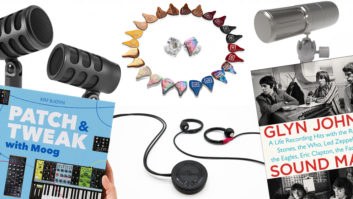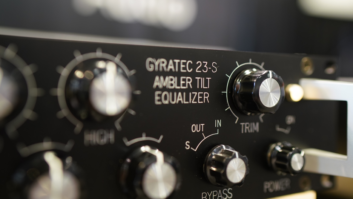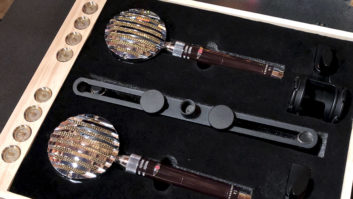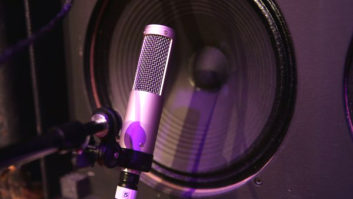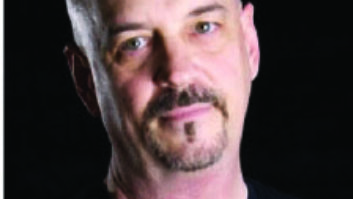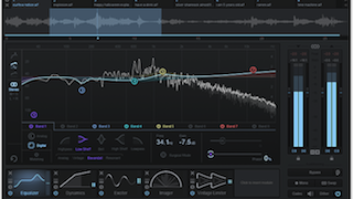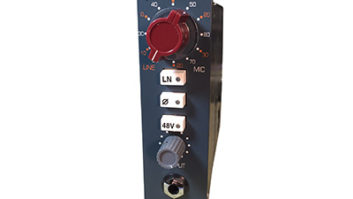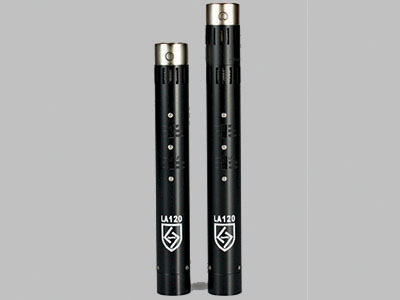
Engineers crave variety in capturing a sound, so there is always room for more microphones. The three products reviewed here bring a wide range of specialties, features and uses. The Lauten LA-120 redefines “entry level” by packaging great-sounding, twin pencil condensers with swappable capsules for just $349. The MXL DX-2 is a dual-capsule dynamic mic allowing you to precisely mix in, or out, both leakage and proximity effect at the mic for just $149. And while the Lewitt LCT 640 TS has a higher price tag, it brings pattern and position control after the recording, plus a unique Clip History feature that is groundbreaking.
LAUTEN LA-120
The Lauten LA-120 ($349) comes as a pair in a well-made wooden box housing the mics, stand clips, foam end-cap pop filters, and a second, interchangeable capsule—one cardioid and the other omni. On the body of the mic are switches for a lowpass filter (10 kHz and 15 kHz) and a highpass filter (50 Hz and 150 Hz). New, and just released at NAMM are optional screw-on pads ($79.99 a pair) offering -10dB of attenuation. Fitting between the capsule and body, the pads add just an inch to the total length of the mic. While the pads are an add-on, they will still fit in the wooden box if you tuck them neatly inside the foam pop-filters, which offers both protection and ready availability.
I first used the pair of LA-120s as utility percussion mics placed in an XY array in cardioid. The simple clips and slender body made it easy to place the mics quickly and accurately. I’ll often place an array of mics like this over a small table with a blanket on top where the percussionist can put various shakers, tambos, triangle, bells and other noise makers. This way, he or she can pick them up and play across the stereo field using a bunch of toys throughout the song. The LA-120s were wide open (no rolloff, no pad) and sounded great. They handled the jangly transients of the tambourine without the distortion and nasty edge that is apparent when using some condensers.
Next, I used the LA-120s in cardioid over a drum kit as a stereo pair, each mic measured at 3-feet, 4-inches from the center of the snare. I immediately appreciated the availability of the lowpass filter, as the mics are bright when flat—but not too bright for this application. I’ll usually add top to my overheads when tracking to bring out the cymbal attack and stick hits on toms and snare drum, but with the LA-120s I needed none. The top is smooth and not strident. The LA-120s paired with the Chandler REDD mic as a center overhead was perfect, as each shined in its strong points: the LA-120s for detail, and the REDD for beautiful tubey midrange.
Next I paired the LA-120s in XY pattern just in front of the sound hole of an acoustic guitar, again using the cardioid capsules. The array offered a nice presentation of the instrument and a beautiful stereo image. I swapped a single mic to the omni capsule and placed it at the sound hole pointing toward the tailpiece. I preferred this single-mic approach for this guitar, which was on the bright side. Pointing the capsule toward the tail rolled off some top end without having to engage the filters.
At this price and quality it’s hard to justify not having the Lauten LA-120s in your locker. They sound great, are easy to place, travel easily in a backpack and offer a range of features. I know of no other mic in this price range or size that gives you both high and lowpass filters, as well as exchangeable capsules, stand mounts and pop filters. What’s not to like?
MXL DX-2

The MXL DX-2 ($149) is a mic with a mission: It is specifically designed for use in both studio or live applications, for reproducing bass and guitar cabinets, kick drums, low toms or other high-SPL instruments. Its unique design lets the flat side point toward the source while the rounded back sports a crossfade knob, allowing fully variable mixing of the two sources at the output. The mic ships in a sturdy zipper bag with a well-made stand mount.
The two capsules inside the DX-2 are time-aligned behind the rigid metal grille; one capsule is cardioid and the other super-cardioid. Capsule 1, super-cardioid, sits at the middle of the mic, with the cardioid capsule about an inch away. When the mic is placed with the XLR facing up, the rotary control mixes 100 percent of Capsule 1 when it’s fully counter-clockwise, and Capsule 2 when fully clockwise. Twelve o’clock blends them 50-50. You can use the inherent nature of each capsule to boost bottom end or midrange and isolate the source. For example, the super-cardioid exhibits less leakage from the side (more source isolation) and greater proximity effect. The cardioid capsule is less directional and exhibits less proximity.
I used the DX-2 outside a kick drum paired with a Sennheiser e602 inside. While the DX-2’s attack was great, even with the super-cardioid capsule fully in play there wasn’t a lot of the booty I search for from an outside mic. After adding a lot of 50 Hz, and cutting 500 Hz to lose the inherent tubbiness from a kick, I still couldn’t dig out what I needed. We quickly swapped the mics, outside to in, but that wasn’t the solution either. The DX-2, especially in super-cardioid mode, needs some air at the back to avoid overly accentuating the clicking of the transient peak.
The DX-2 worked much better on a bass and guitar cabinet. It’s a simple matter to mount by pointing the flat side toward the speaker. Some live sound engineers just hang the mic from the top of the cabinet, letting it sit right on the grille cloth (some gaff tape on the cable as it passes over the amp is recommended to avoid slippage). The DX-2 is designed with this technique in mind—the flat side of the mic perfectly sits against the amp. For studio use, however, use the sturdy stand mount (included), which offers a better opportunity for tight and accurate placement.
Used to record a bass cabinet, the DX-2 sounded best when I dialed the mix knob to the super-cardioid position. On the other hand, on a guitar amp, I could dial back the low end and accentuate the mids by rotating clockwise. This greatly eliminated the need for EQ since I was EQ’ing at the mic without phase shift. For live use, you can use the mix feature to reduce stage spill from adjacent amps or other instruments by leaning more toward Capsule 1. Using capsule design to tailor your sound is nothing new, but having the ability to mix between two different capsules in a single mic is brilliant.
In addition to its affordable price, the DX-2 offers a wickedly simple way to tailor sound at the source without power, EQ or even moving the mic. At this price, you should have at least one, or more. The DX-2 is a new classic.
LEWITT LCT 640 TS

Mics offering emulation and pattern control are all the rage now, with the Slate VMS and Townsend Labs Sphere L22 just coming to market. Earlier out of the gate and the most affordable of the group is the Lewitt LCT 640 TS phantom-powered condenser ($899). It ships in a waterproof SKB case that houses the mic, a zipper bag, a well-made shock mount, magnetically mounted metal pop filter, foam pop filter, and a mini-XLR female to male XLR for the output of the back capsule.
The 640 TS features a 1-inch dual-diaphragm with pushbutton controls and lighted readouts for the highpass filter (0, 40, 80, 160 Hz), pad (0, -6, -12, -18 dB) and pattern switching (omni, wide cardioid, cardioid, super-cardioid, and figure-8). I immediately appreciated the lit controls, which give you instant confidence that the mic is receiving phantom power, a feature that can save a lot of time when troubleshooting.
The 640 TS takes itself beyond basic by offering three more modes accessed by pushing and holding the same three buttons used to access the previously mentioned pattern, pad and rolloff features. For example, by holding down the left button for two seconds, you can lock the pattern, pad and rolloff so they can’t be changed accidentally. Holding the right button for two seconds engages the Clip History feature. If the mic sees an overload any time after power-up, the logo will flash red and engage the pad feature for use. By holding the center button for two seconds, the mic enters Dual Output Mode, where all pattern lights go out, and the front and rear outputs are engaged for recording.
The rear output is accessed via the mini-XLR connector at the side of the mic. This is easier than it sounds; the included mini-connector is robust, and the cable easily wraps around the stand, which then runs to a second preamp. The two outputs are recorded to a stereo track in your DAW with both outputs panned the same. This allows you to manipulate the pattern and mic orientation later using the included Polarizer multichannel plug-in.
This is where you can really get your head around what polar patterns bring to a recording—by hearing and seeing the results instantly. Because the Polarizer is a Native plug-in, it can’t be used during recording. Even with the trick of putting an AAX plug-in first in the chain (such as trim), the plug-in has over 2,000 samples of latency (at 48k) and can’t be delay compensated live. So when recording, you can still hear the output, but you don’t have the ability to audition polar patterns.
Once you stop recording and engage Delay Compensation, you can hear what the 640 and Polarizer plug-in brings to the game. For example, when I used the 640 TS as a room mic in Dual Output mode, I was able to completely change the orientation and pattern after the band went home. I placed the mic 16 feet back from the drum kit at the door of a live chamber in Blackbird’s Studio A. This way I could use the Polarizer to bring out the chamber’s deliciousness, or mix in the direct (front) of the mic pointing at the kit. How great this is can’t be overstated. It will change how you work.
Placing mics properly in the first place is important, but in the heat of battle, you can’t possibly audition the many combinations of pattern and position that the Polarizer software offers. Later, I used the 640 TS as an omni overhead about 4 feet over the center of the snare. The relatively tight placement gave me a drier front capsule sound; later, using the Polarizer, I could also open up the room (which had an 18-foot ceiling) by mixing in the back capsule closer to 100 percent. This, when mixed in with the stereo overheads, gave me an incredible range of close-to-room alternative mix options.
Next, I placed the 640 TS set in Dual Output mode in front of the sound hole on acoustic guitar. When recording acoustic, you’re often fighting with the proximity of the mic to the instrument or position around the sound hole to avoid boominess. With the Polarizer plug-in you can dial back from cardioid to omni (or anywhere between) to instantly, and incrementally, reduce proximity effect.
The Lewitt LCT 640 TS is an affordable mic that you will use all the time. The Dual Output mode is so incredibly useful I can’t see any reason not to engage it every time you record with the mic. When you have such a sonically excellent condenser like this under $900 and then add in the unique feature set, you have to try it; what have you got to lose?

